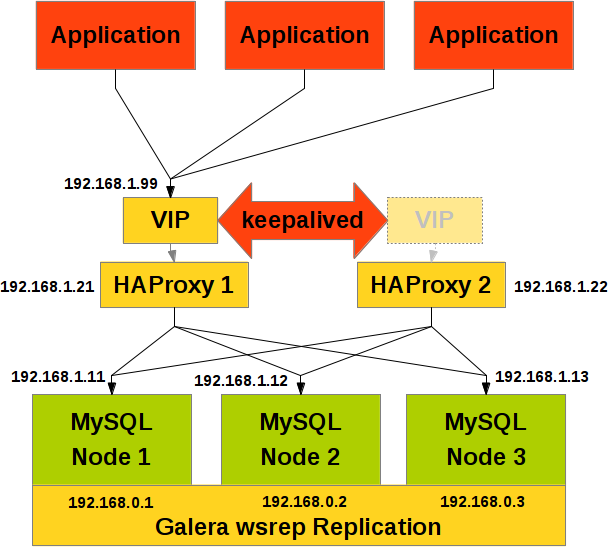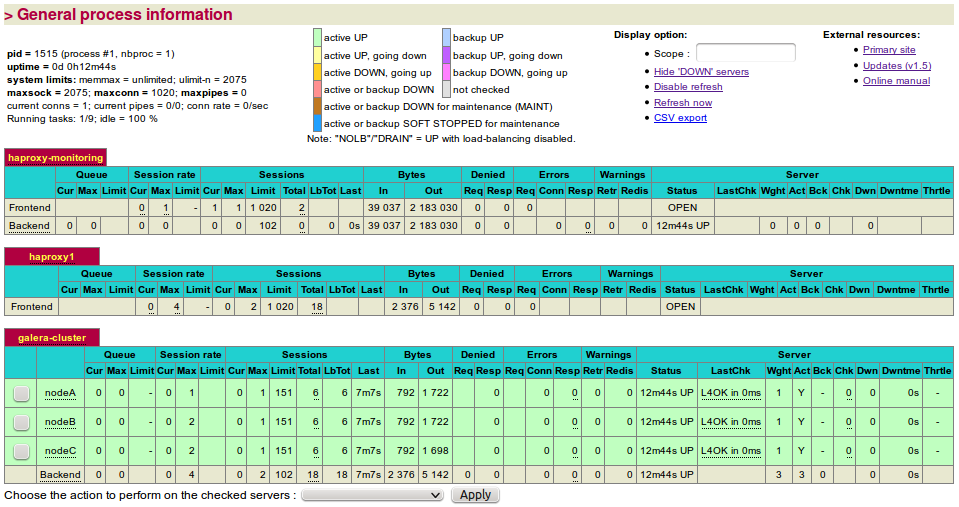You are here
Making HAProxy High Available for MySQL Galera Cluster
After properly installing and testing a Galera Cluster we see that the set-up is not finished yet. It needs something in front of the Galera Cluster that balances the load over all nodes.
So we install a load balancer in front of the Galera Cluster. Typically nowadays HAProxy is chosen for this purpose. But then we find, that the whole Galera Cluster is still not high available in case the load balancer fails or dies. So we need a second load balancer for high availability.
But how should we properly failover when the HAProxy load balancer dies? For this purpose we put a Virtual IP (VIP) in front of the HAProxy load balancer pair. The Virtual IP is controlled and failovered with Keepalived.

Installation of HAProxy and Keepalived
First some preparations: For installing socat we need the repoforge repository:
shell> cd /download shell> wget http://pkgs.repoforge.org/rpmforge-release/rpmforge-release-0.5.3-1.el6.rf.x86_64.rpm shell> yum localinstall rpmforge-release-0.5.3-1.el6.rf.x86_64.rpm shell> yum update shell> yum install socat
Then we can start installing HAProxy and Keepalived:
shell> yum install haproxy keepalived shell> chkconfig haproxy on shell> chkconfig keepalived on
We can check the installed HAProxy and Keepalived versions as follows:
shell> haproxy -v HA-Proxy version 1.5.2 2014/07/12 shell> keepalived --version Keepalived v1.2.13 (10/15,2014)
Configuration of HAProxy
More details you can find in the HAProxy documentation.
shell> cp /etc/haproxy/haproxy.cfg /etc/haproxy/haproxy.cfg.bak # This HAProxy configuration was tested with version 2.6.12 shell> cat << _EOF >/etc/haproxy/haproxy.cfg # # /etc/haproxy/haproxy.cfg # #--------------------------------------------------------------------- # Global settings #--------------------------------------------------------------------- global # to have these messages end up in /var/log/haproxy.log you will # need to: # # 1) configure syslog to accept network log events. This is done # by adding the '-r' option to the SYSLOGD_OPTIONS in # /etc/sysconfig/syslog # # 2) configure local2 events to go to the /var/log/haproxy.log # file. A line like the following can be added to # /etc/sysconfig/syslog # # local2.* /var/log/haproxy.log # log 127.0.0.1 local2 chroot /var/lib/haproxy maxconn 1020 # See also: ulimit -n user haproxy group haproxy daemon # turn on stats unix socket stats socket /var/lib/haproxy/stats.sock mode 600 level admin stats timeout 2m #--------------------------------------------------------------------- # common defaults that all the 'frontend' and 'backend' sections will # use if not designated in their block #--------------------------------------------------------------------- defaults mode tcp log global option dontlognull option redispatch retries 3 timeout queue 45s timeout connect 5s timeout client 1m timeout server 1m timeout check 10s maxconn 1020 #--------------------------------------------------------------------- # HAProxy statistics backend #--------------------------------------------------------------------- listen haproxy-monitoring bind *:80 mode http stats enable stats show-legends stats refresh 5s stats uri / stats realm Haproxy\ Statistics stats auth monitor:AdMiN123 stats admin if TRUE frontend haproxy1 # change on 2nd HAProxy bind *:3306 default_backend galera-cluster backend galera-cluster balance roundrobin server nodeA 192.168.1.61:3306 maxconn 151 check server nodeB 192.168.1.62:3306 maxconn 151 check server nodeC 192.168.1.63:3306 maxconn 151 check _EOF
Starting and testing HAProxy
The HAProxy can be started as follows:
shell> service haproxy start
and then be checked either over the socket:
shell> socat /var/lib/haproxy/stats.sock readline prompt > show info > show stat > help
or over your favourite web browser entering the username and password (monitor:AdMiN123) specified in the configuration file above:

To check the application over the load balancer we can run the following command:
shell> mysql --user=app --password=secret --host=192.168.1.38 --port=3306 --exec="SELECT @@wsrep_node_name;" +-------------------+ | @@wsrep_node_name | +-------------------+ | Node C | +-------------------+ shell> mysql --user=app --password=secret --host=192.168.1.38 --port=3306 --exec="SELECT @@wsrep_node_name;" +-------------------+ | @@wsrep_node_name | +-------------------+ | Node A | +-------------------+ shell> mysql --user=app --password=secret --host=192.168.1.38 --port=3306 --exec="SELECT @@wsrep_node_name;" +-------------------+ | @@wsrep_node_name | +-------------------+ | Node B | +-------------------+
Configuration a Virtual IP (VIP) with Keepalived
Now we have 2 HAProxy load balancers. But what happens if one of them fails. Then we do not want to reconfigure our application to work properly again. The failover should happen automatically. For this we need a Virtual IP which should automatically failover.
More details you can find in the Keepalived documentation and the keepalived user guide.
shell> cp /etc/keepalived/keepalived.conf /etc/keepalived/keepalived.conf.bak
cat << _EOF >/etc/keepalived/keepalived.conf
#
# /etc/keepalived/keepalived.conf
#
global_defs {
notification_email {
remote-dba@fromdual.com
root@localhost
}
# Change email from on lb2:
notification_email_from lb1@haproxy1
router_id HAPROXY
}
vrrp_script chk_haproxy {
script "killall -0 haproxy"
interval 2
weight 2
}
vrrp_instance GALERA_VIP {
interface eth1
virtual_router_id 42
# Higher priority on other node
priority 101 # 102
advert_int 1
# notify "/usr/local/bin/VRRP-notification.sh"
virtual_ipaddress {
192.168.1.99/32 dev eth1
}
track_script {
chk_haproxy
}
authentication {
auth_type PASS
auth_pass secret
}
}
_EOF
Starting and testing Keepalived
To test the keepalived we can run the following command:
shell> keepalived -f /etc/keepalived/keepalived.conf --dont-fork --log-console --log-detail ^C
To finally start it the following command will serve:
shell> service keepalived start
To check the Virtual IP the following command will help:
shell> ip addr show eth1
And then we can check our application over the VIP:
shell> mysql --user=app --password=secret --host=192.168.1.99 --port=3306 --exec="SELECT @@wsrep_node_name;"
Literature
- Brian Seitzer: Redundant Load Balancers – HAProxy and Keepalived
- Shinguz's blog
- Log in or register to post comments
